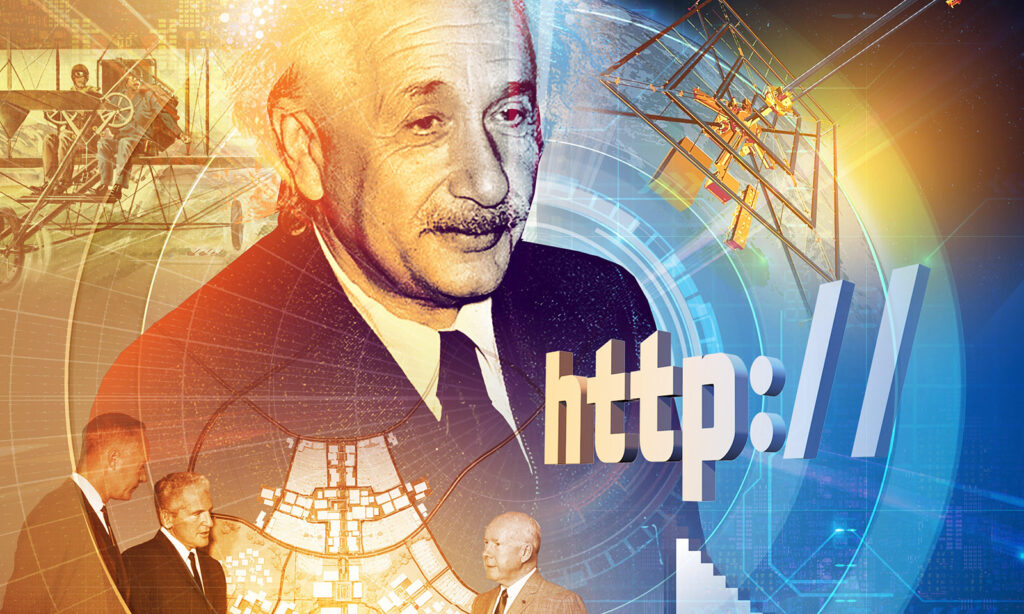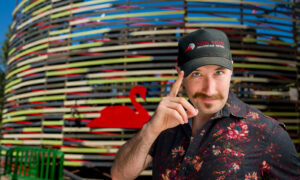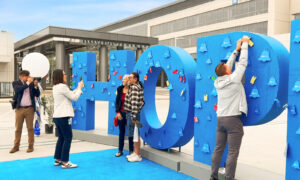First flight
California’s first recorded flight started in an Irvine bean field in 1909. Aviator Glenn Martin lifted up 8 feet during that 12-second flight. Three years later, he broke an American over-water record by flying 68 miles from Newport Beach to Catalina Island and back. In 1913, he thanked his early supporter, James H. Irvine, with a 20-minute flight over The Irvine Ranch.
Speed of light
In 1929, Nobel Prize winner Albert Michelson got permission from James Irvine II to build a milelong, steel vacuum tube on an Irvine Ranch bean field. Bouncing light off mirrors inside that tube, he became the first person to accurately measure the speed of light. Those measurements helped Albert Einstein develop his theory of relativity.
Medtech emerges
Founded in 1948 by Gavin S. Herbert, medtech pioneer Allergan was headquartered in Irvine as it grew into one of the most significant medical aesthetics innovators in the world. Thanks to the influence of the company and its research, Irvine has grown into a global center of ophthalmological research, which includes UC Irvine’s Gavin Herbert Eye Institute.
Heart valve home
The artificial heart valve developed in the late 1950s by Orange County engineer and inventor Miles “Lowell” Edwards and surgeon Dr. Albert Starr began the era of surgically treating heart valve disease. In 1958, Edwards founded Edwards Lifesciences Corp., which soon moved to its headquarters in Irvine and became the worldwide leader in tissue replacement heart valves and heart valve repair products. More than 250,000 patients around the world have received the life-changing heart valve, while millions have benefited from Edwards innovations.
City vision
The Irvine Ranch Master Plan was created by Irvine Company in 1960 when The Irvine Ranch was agricultural. No U.S. city the size of Irvine has been master planned. The visionary initiative called for a balance of land uses to support economic growth and promote quality of life, including a variety of housing types, job centers, shopping centers, generous recreation and abundant open space. The Master Plan has served as a foundation for innovation in Irvine, adding key infrastructure – including UC Irvine and a culture of education – as well as industrial parks and premier office space.
Water works
In 1967, the Irvine Ranch Water District’s Michelson plant began delivering about 2 million gallons per day of recycled water to agricultural users. Over the years, the district’s water recycling program grew to a nationally recognized program that provides water for a variety of other nondrinking uses. Today the district’s recycled water production capacity has grown to 28 million gallons per day, and 85% of the landscaping in Irvine is irrigated using recycled water.
Web master
Roy Fielding was a software researcher at UCI’s Donald Bren School of Information and Computer Sciences in 1993 when he co-authored a new way to retrieve and view documents on the internet. The hypertext transfer protocol – known as HTTP – changed the internet forever.
Laser focus
UCI Beckman Laser Institute specialists, led by Dr. J. Stuart Nelson, invented and patented pioneering laser surgery cooling technology in 1992. The invention made possible the early, painless, safe and effective treatment of disfiguring birthmarks in infants and young children. The technology is now the standard of care and is incorporated into more than 25,000 laser systems worldwide; it is also the top revenue producing patent at UC Irvine, earning $60 million.
Ozone savior
In 1995, UC Irvine chair of chemistry F. Sherwood Rowland and his research team discovered that chlorofluorocarbons (CFCs) released into the atmosphere were depleting Earth’s vital ozone layer. He worked tirelessly to publicize the research, bringing worldwide attention to the impact, which led to international regulations limiting their production and use. When he won the Nobel Prize, the award committee said Rowland’s work may have “saved the world from catastrophe.”
Think tanks
Since it debuted in 1996, UCI Research Park has served as an incubator for innovative new products and services. The park has grown to include 185 acres of land and 2.4 million square feet of research space that offers companies access to UCI innovators and the city’s entrepreneurial infrastructure.
Solar from space
In 2011, Irvine Company Chairman Donald Bren and Caltech created a space-based solar power research project. Since then, the philanthropist has contributed more than $100 million to Caltech’s Space Solar Power Project, which promises to provide abundant, reliable and affordable energy that can be delivered all over the world.
VR virtuoso
In 2014, Facebook acquired Irvine-based Oculus VR for $2.3 billion. Founded by Palmer Luckey in his parents’ garage, his Oculus Rift virtual reality headset made the long-held vision of a consumer virtual reality industry a reality.
Clean care
UCI Health is building the first all-electric, zero-emission hospital in the nation on its new Irvine campus. The hospital on Jamboree Road will operate on clean energy, with no carbon combustion or natural gas as power sources, a breakthrough for the medical industry. The seven-story, 350,000-square-foot acute care hospital and emergency department is scheduled to open in December 2025.










